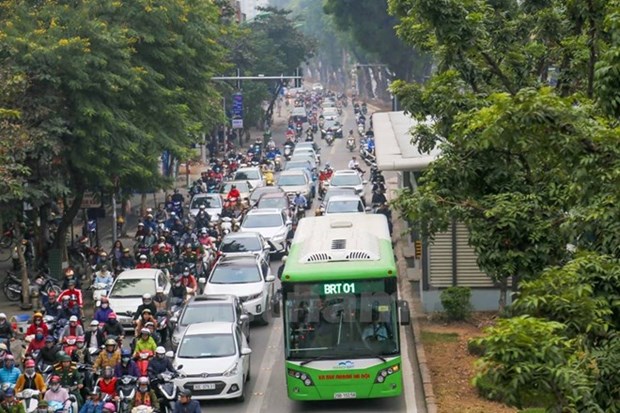 Society
Society


|
| Other vehicles still use the supposedly exclusive BRT lanes in Hà Nội. — VNA/VNS Photo |
HÀ NỘI — While the Hà Nội People's Committee believes the Kim Mã-Yên Nghĩa Bus Rapid Transits (BRT) has helped reduce traffic congestion, some voters in the city feel the BRT has failed to meet their expectations.
Responding to the voters' complaints about the effectiveness of the BRT, raised before the 10th meeting of the municipal People's Council slated to open early next month, the city People's Committee said the BRT has generated positive results.
According to the report, people have given positive feedback about the BRT. The report shows that service quality is stable, the number of passengers using the BRT keeps increasing, and revenue from the BRT remains high.
The Hà Nội People's Committee cited data showing that between 2017 to 2019, the total number of passengers using BRT fluctuated between 4.9-5.5 million/year and increased year by year.
During the COVID-19 pandemic from 2020 to 2021, the passenger number decreased from 5.35 million in 2020 to 1.82 million in 2021.
In the first half of this year, about 2.44 million passengers used the BRT.
On average, the number of passengers on every BRT trip was 40, 42 and 43 in 2017, 2018 and 2019, respectively.
During rush hours, the number of passengers can reach 100 passengers per trip.
Between 2020-2022, due to the impact of the COVID-19 pandemic, there were times when buses had to stop operating and reduce capacity, so the output and revenue of the BRT route decreased.
In 2020, there were more than 45 passengers per trip; in 2021 only 23 passengers per trip; in the first half of 2022, the average number of passengers per trip reached more than 45 passengers.
The number of passengers with monthly tickets is quite high, with 1,600 people per month in 2017, 2,200 people per month in 2018 and 2,100 people per month in 2019. The report doesn't mention figures from 2020 to now.
The revenue of the BRT is considered good compared to the regular buses, but the subsidy rate tends to increase. Accordingly, the revenue of the BRT route reached VNĐ25 billion in 2017, then increased to VNĐ27.5 billion in 2018 and nearly VNĐ25 billion in 2019.
The subsidy rate increased from more than 26 per cent in 2016 to over 36 per cent in 2019 and over 65 per cent in 2021.
The city authority says that the BRT still has some shortcomings, such as other vehicles still using the lanes designated for the BRT, some BRT stops not accessible by footbridges and no electronic ticket system.
The Kim Mã - Yên Nghĩa BRT route was approved in 2007 with a total investment of $55 million. On January 1, 2017, the route started operating on the route Yên Nghĩa - Ba La - Lê Trọng Tấn - Tố Hữu - Lê Văn Lương - Láng Hạ - Giảng Võ - Kim Mã bus station. It takes about 45 minutes to travel the entire 14.77km route.
Over the years, agencies have twice proposed vehicles enter the BRT priority lane.
In early 2018, the Centre for Management and Operation of Urban Traffic under the Hà Nội Department of Transport proposed normal buses use the BRT lanes from 4am to 11pm, while other vehicles be allowed to use the lanes from 11pm to 4am the next day.
In June 2022, the Hà Nội Department of Transport proposed that busses with 24 seats or more, official vehicles and ambulances be allowed to use BRT lanes. However, the city authority has not responded publicly to the above suggestions.
The effectiveness of the Kim Mã - Yên Nghĩa BRT route in reducing traffic congestion also has mixed opinions because part of the route, particularly from Kim Mã to Lê Văn Lương Street and Tố Hữu Street usually suffers from heavy traffic congestions during rush hours. — VNS




